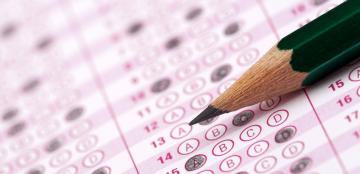
Coronavirus Has Disrupted Standardized Testing – Don’t Panic
The coronavirus pandemic has created an unprecedented level of disruption for students and the schools that serve them. In response to the changing environment, higher education institutions have done momentous work in quickly supporting faculty in moving their courses online and in ensuring that students stay connected to their studies, fellow classmates, and essential institutional services.
Yet, much uncertainty remains as colleges and universities look ahead to the next academic year. One pressing issue for colleges and universities is having to make placement decisions in the absence of a tool that historically has been central to those decisions: standardized tests.
With the widespread cancellations of the ACT and SAT due to the COVID-19 outbreak, increasing numbers of institutions have adopted a “test optional” admissions policy. However, for the thousands of students who enter postsecondary institutions without demonstrated “readiness” for college-level mathematics, such as SAT/ACT scores, many will have to complete a placement test to determine eligibility for certain mathematics courses.
Since most institutions will continue to face serious challenges in administering placement tests for incoming students, this is an opportune time to consider new measures of student readiness for college-level mathematics courses. Fortunately, there is a widely used and easily accessible measure of student readiness, which research has shown that consistently outperforms traditional placement tests for predicting student success: high school GPA.
Research shows high school GPA is a better predictor of student success.
Placement tests are almost ubiquitous in postsecondary education. A recent national survey from the Center for Analysis of Postsecondary Readiness found that 99% of two-year colleges and 94% of four-year universities use some form of standardized test to determine a student’s mathematics course placement.1
Despite their widespread use, standardized placement tests are notoriously unreliable at doing the one thing they are intended to do: evaluate student readiness for college-level coursework. In fact, placement tests have consistently been shown to underestimate students’ potential for success, especially when compared to students’ high school performance. A 2017 report from the Community College Research Center (CCRC) found that “using test scores alone to make placement decisions resulted in large numbers of ‘severe placement errors.’”2 A U.S. Department of Education report noted that single, high-stakes placement exams on their own “do not reliably place students into the appropriate level of course-taking” once a student enrolls in college.3
Placement tests have consistently been shown to underestimate students’ potential for success, especially when compared to students’ high school performance.
Given both the unreliability of the assessments and the limited availability for testing due to the coronavirus, state agencies and systems of higher education need to quickly consider viable alternatives for placing students into college courses. Fortunately, there is a readily available and highly accurate measure of readiness that practically every incoming undergraduate student brings with them: their high school grade point average (GPA).
High school GPA is a robust measure of readiness because it captures information about student performance over multiple years and across teachers and subjects. Placement tests, on the other hand, tend to occur at a single moment in time with a small set of multiple choice questions that are often narrowly focused, algebraically-intensive mathematics content that may not even be relevant to the courses students need to take. The same CCRC analysis found that, compared to placement test scores, high school GPA alone more accurately placed students into appropriate courses.
Further, many states and systems are already using high school GPA as the primary measure for placing students into college-level coursework. For example, in California, legislation passed in 2018 (AB 705) requires that the state’s community colleges use high school GPA for placement decisions. A policy scan conducted by the Education Commission of the States in 2018 similarly found that 19 states require some other form of college-readiness measurement beyond standardized placement exams—typically a combination of assessment scores and high school GPA.4
When combined with existing reform efforts, including guided pathways, mathematics pathways, and co-requisite remediation, the use of high school GPA as a placement tool can lead to improved student retention, persistence, and success.
Use the disruption to make changes towards equity and accuracy.
As both K–12 and higher education systems are forced to make changes to “traditional” forms of instruction, learning, and assessment in response to extraordinary challenges brought on by the coronavirus pandemic, now is the time to re-examine placement policies in a way that is beneficial to students.
While many challenges will persist, state, system, and institutional education leaders can use this disruption to the current model as an opportunity to change the way they assess students’ academic abilities, and more accurately and equitably place them into college-level courses.

Numerous resources and organizations with the technical expertise can help guide efforts to re-imagine placement policy in higher education. Since 2010, the California Acceleration Project has addressed issues related to placement and developmental education through research and advocacy. The Strong Start to Finish initiative similarly focuses on redesigning the first year of college in a way that boosts student outcomes and increases equity and opportunity. And of course, the guided pathways and mathematics pathways movements—led by places such as the American Association of Community Colleges, CCRC, and the Charles A. Dana Center—continue to strive towards the systemic adoption of student-centered practices and policies that likewise focus on equitable outcomes increased social mobility.
Through the use of multiple measures for placement, education stakeholders can improve the student experience for the better and help students navigate what is already an often complex and unpredictable process in an increasingly uncertain and complicated world.
1 https://postsecondaryreadiness.org/wp-content/uploads/2019/11/changing-landscape-developmental-education-practices.pdf
2 https://ccrc.tc.columbia.edu/media/k2/attachments/designing-meaningful-developmental-reform-research-overview.pdf
3 https://www2.ed.gov/about/offices/list/opepd/education-strategies.pdf
4 https://www.ecs.org/50-state-comparison-developmental-education-policies/
About the Author
Carl Krueger
My unlikely journey from college dropout to a Master’s degree helped me understand the difficult and unorthodox pathways students take to realize their true passions. Since I began work in education policy over 18 years ago, my passion for helping students successfully navigate the path through college to a career that provides both fulfillment and social mobility has not wavered.
About the Author
Jeremy Martin
In my 6 years teaching in Austin-area schools, I worked hard every day to create a caring, inclusive, and empowering classroom community for my students. Now I work on the policies that shape what happens in classrooms in Texas and beyond. One of the reasons that I remain motivated by the mission of the Center—equity, access, and excellence in math and science education—is to ensure that all students can reclaim a place in the community of mathematical learners.
Get in Touch
We collaborate with states, districts and teachers to develop innovative curricula, resources, and professional development.


